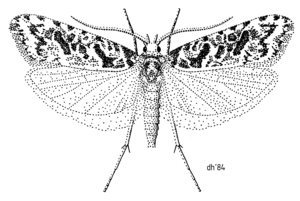Heterocrossa eriphylla facts for kids
Quick facts for kids Heterocrossa eriphylla |
|
|---|---|
 |
|
| Heterocrossa eriphylla illustrated by Des Helmore | |
| Scientific classification | |
| Kingdom: | |
| Phylum: | |
| Class: | |
| Order: | |
| Family: |
Carposinidae
|
| Genus: | |
| Species: |
H. eriphylla
|
| Binomial name | |
| Heterocrossa eriphylla Meyrick, 1888
|
|
| Synonyms | |
|
|
The lichen snoutlet moth (scientific name: Heterocrossa eriphylla) is a type of moth found only in New Zealand. It belongs to the Carposinidae family. This moth is special because its caterpillars (larvae) eat the healing parts of New Zealand beech trees.
Contents
About the Lichen Snoutlet Moth
Naming and Classification
This moth was first described in 1888 by a scientist named Edward Meyrick. He found a specimen in Wellington. Over the years, scientists discussed where this moth should fit in the moth family tree. In 1988, John S. Dugdale finally placed it back into the Heterocrossa group. The original specimen used to describe the moth is kept at the Natural History Museum, London.
What it Looks Like
The adult lichen snoutlet moth is about 2.6 centimeters (about 1 inch) wide when its wings are spread. Its head and body are a mix of whitish-green, and its shoulders are olive-green. Its wings are pale green with white speckles, especially near the edges. It has small black spots and green markings on its wings. These colors help the moth blend in with its surroundings, like lichens on tree trunks.
Where it Lives
The lichen snoutlet moth is endemic to New Zealand, meaning it's found nowhere else in the world. You can find it in the North Island and the northern parts of the South Island. It has been seen in places like the Wellington Botanic Gardens, the Orongorongo Valley, and near Woodville. This moth is considered quite uncommon.
Life and Habits
Adult lichen snoutlet moths are usually seen flying from December to April, and sometimes in May and June. They are night fliers and are often attracted to lights. During the day, these moths rest on tree trunks. Their special colors help them hide, looking just like the lichens and bark on the trees.
The caterpillars of this moth have a unique diet. They feed on the soft, healing tissue that grows on beech trees after they've been damaged by other insects. This feeding can sometimes stop the tree wounds from closing properly, which might lead to rot in the beech trees. The caterpillars also turn into pupae right where they eat.
Host Trees
The lichen snoutlet moth lives in native forests. Its caterpillars feed on the wood of two types of New Zealand beech trees: the red beech (Fuscospora fusca) and the hard beech (Fuscospora truncata).
Images for kids


